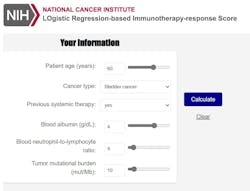NIH scientists develop AI tool to predict how cancer patients will respond to immunotherapy
In a proof-of-concept study, researchers at the National Institutes of Health (NIH) have developed an artificial intelligence (AI) tool that uses routine clinical data, such as that from a simple blood test, to predict whether someone’s cancer will respond to immune checkpoint inhibitors, a type of immunotherapy drug that helps immune cells kill cancer cells.
The machine-learning model may help doctors determine if immunotherapy drugs are effective for treating a patient’s cancer. The study, published June 3, 2024, in Nature Cancer, was led by researchers at the National Cancer Institute’s (NCI) Center for Cancer Research and Memorial Sloan Kettering Cancer Center in New York. NCI is part of the National Institutes of Health.
The new study details a different kind of machine-learning model that makes predictions based on five clinical features that are routinely collected from patients: a patient’s age, cancer type, history of systemic therapy, blood albumin level, and blood neutrophil-to-lymphocyte ratio, a marker of inflammation. The model also considers tumor mutational burden, assessed through sequencing panels. The model was constructed and evaluated using data from multiple independent data sets that included 2,881 patients treated with immune checkpoint inhibitors across 18 solid tumor types.
The model accurately predicted a patient’s likelihood of responding to an immune checkpoint inhibitor and how long they would live, both overall and before the disease returned. Notably, the researchers said, the model was also able to identify patients with low tumor mutational burden who could still be treated effectively with immunotherapy.
The researchers noted that larger prospective studies are needed to further evaluate the AI model in clinical settings. They have made their AI model, called Logistic Regression-Based Immunotherapy-Response Score (LORIS), publicly available at https://loris.ccr.cancer.gov. The tool estimates the likelihood of a patient responding to immune checkpoint inhibitors based on data on the six variables described above.

